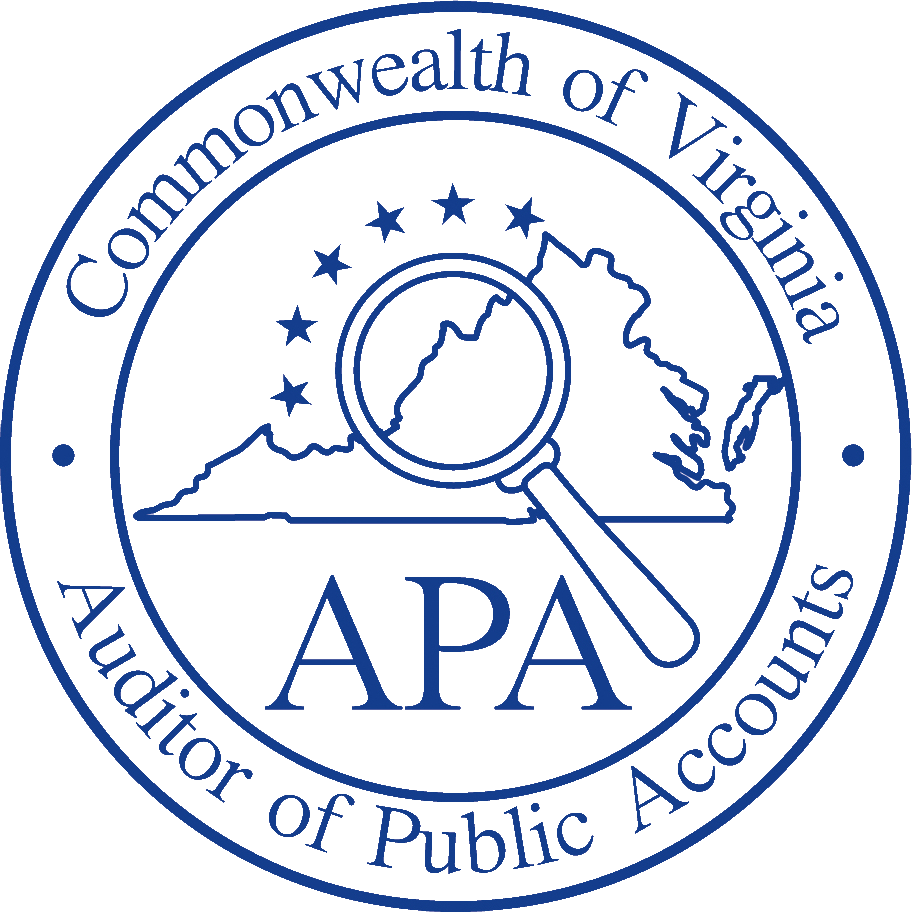
Commonwealth Data Point is the result of legislation sponsored by Senator Walter A. Stosch, who wanted the public to have readily accessible demographic data and detailed state financial figures. What started out as a simple website that displayed state agencies and institutions revenue and expenditure transactions has turned into a data center for the Commonwealth's operations.
Data Point was created and maintained by the Virginia Auditor of Public Accounts. The APA obtains the data for this website from the Commonwealth financial reporting and accounting systems, the state's higher education financial systems, and each applicable agency's related system.
The APA does not own the data displayed on Data Point. If you have any questions about specific financial figures, please contact that agency's fiscal officer. You can find each officer's contact information by navigating to their agency dashboard page.
Whether you want to see the state's purchases for the year or the salaries of the state's full-time employees, Commonwealth Data Point offers key financial information about the Commonwealth of Virginia and the operations of state government.
Data Point includes every state transaction, including all contract payments, except where information has been exluded or redacted if deemed confidential by the Virginia Freedom of Information Act, the Family Educational Rights and Privacy Act, the Health Insurance Portability and Accountability Act, or other state and federal regulations.
Commonwealth Data Point's goal is to make its data clear and easily understood by the Commonwealth's citizens and policy makers. View the state's financial information broken down in concise charts and graphs.
The Government of Virginia is comprised of three branches that work together to carry out the mission of the Commonwealth. These include the Legislative, Executive, and Judicial branches, which are comprised of over 100 different agencies collectively. There are also Independent agencies that operate outside of the three branches of state government.
The most well-known portion of the legislative branch is the Virginia General Assembly, which is divided into two parts, a 40-member Senate and a 100-member House of Delegates. The Virginia General Assembly is responsible for enacting state laws, approving the budget, confirming the governor’s appointments, and electing judges and other public officials.
Agencies within the Legislative branch include:
The Governor heads the executive branch of the state government. The Governor is responsible for overseeing the state bureaucracy, preparing the biennial state budget, overseeing the execution of state laws and policies, proposing legislation, and appointing cabinet secretaries, heads of various state agencies, and members of policy-setting boards and commissions.
Agencies within the Executive branch include:
The judicial branch is the state’s court system. The Judicial branch makes rulings on cases about people being accused of breaking the law and whether or not a law agrees with Virginia’s constitution. This system is comprised of the Supreme Court of Virginia, the Court of Appeals of Virginia, circuit courts in thirty-one judicial circuits, general district and juvenile and domestic relations district courts in thirty-two districts, and magistrates in offices in thirty-two districts.
Agencies within the Judicial branch include:
There are six independent agencies in the Commonwealth that do not report through any of the three branches of state government but still receive their spending authority through the Appropriation Act.
The independent agencies are:
The Secretariats are the departments of the Executive Branch and are comprised of the agencies that relate to their secretarial function. The Secretariats are lead by the Cabinet Secretaries, the most senior officers of the executive branch.
An agency is a department of the Virginia state government located beneath the Secretariats or the Branches of Government and is responsible for the oversight and administration of a specific function. Within the state government, there are over 100 state agencies and offices, each with its own area of responsibilities and duties to perform that serve the Commonwealth of Virginia.
The budget is the Commonwealth's financial forcast of expenses for each fiscal year, split into the capital and operating budgets. Because the budget is a forecast, it contains no transactional data, unlike the revenue and expenditure dashboards.
The capital budget deals with allocating money for the acquisition, construction, and maintenance of fixed assets such as land, buildings, and equipment.
The operating budget alloccates money towards maintaining the operations of the Commonwealth, which includes expenses such as salaries and interest payments.
The program structure is a mechanism whereby the State’s activities and services and corresponding expenditures can be conveniently and uniformly organized, clearly identified, and easily accounted for.
A function is the broadest aggregation of state government efforts stated as its general purpose.
The current functions are:
Education
Undesignated Programs or Clearing Accounts
Administration of Justice
Individual and Family Services
Resource & Economic Development
Transportation
General Government
Enterprises
A program is defined as the distinct organization of resources directed toward a specified objectives, which include:
Service areas are the broadest subdivisions of a program. Subfunctions are defined as the broadest subdivision of efforts within a function which describes an aggregation of programs.
The expenditure structure is used by the Commonwealth for classifying different types of expenditures and for collecting expenditure information. The information is used for accounting control and financial management. The expense category is the primary designation of the expenditure.
The Revenue Source Code indicates the origin of revenue or income for the state. The revenue category is the primary designation of revenue source code.
Funds are how the primary government is structured to account for specified financial activities of the Commonwealth. They are independent fiscal and accounting entities with a self-balancing set of accounts that may have financial transactions with other funds of the State. There are ten funds currently established to account for specified financial activities of the Commonwealth.
A transaction is any agreement, communication, or movement carried out between a buyer and a seller to exchange an asset for payment. The state economy is made up of both Revenue and Expenditure transactions, which are assigned to various funds based on the activity involved.